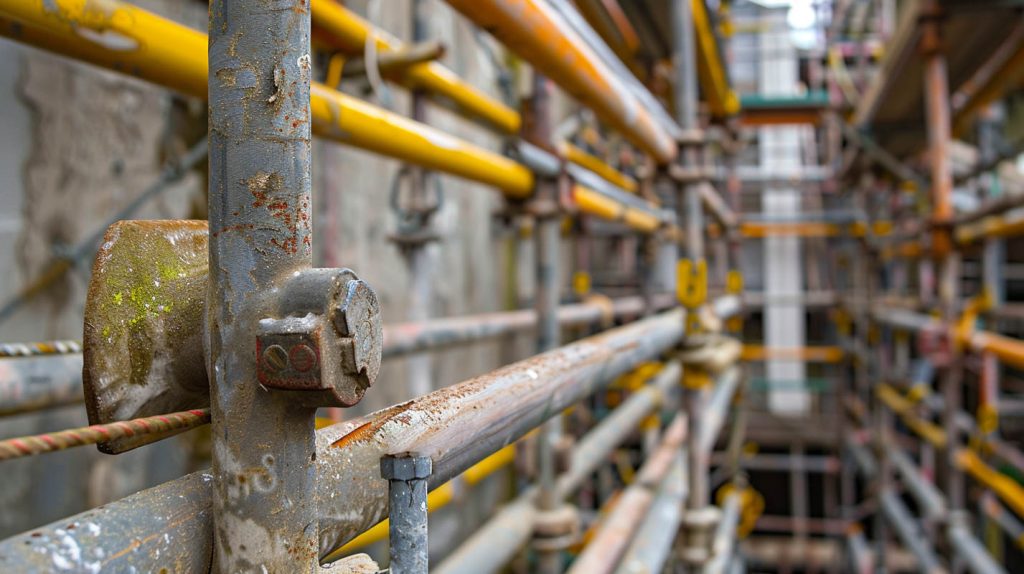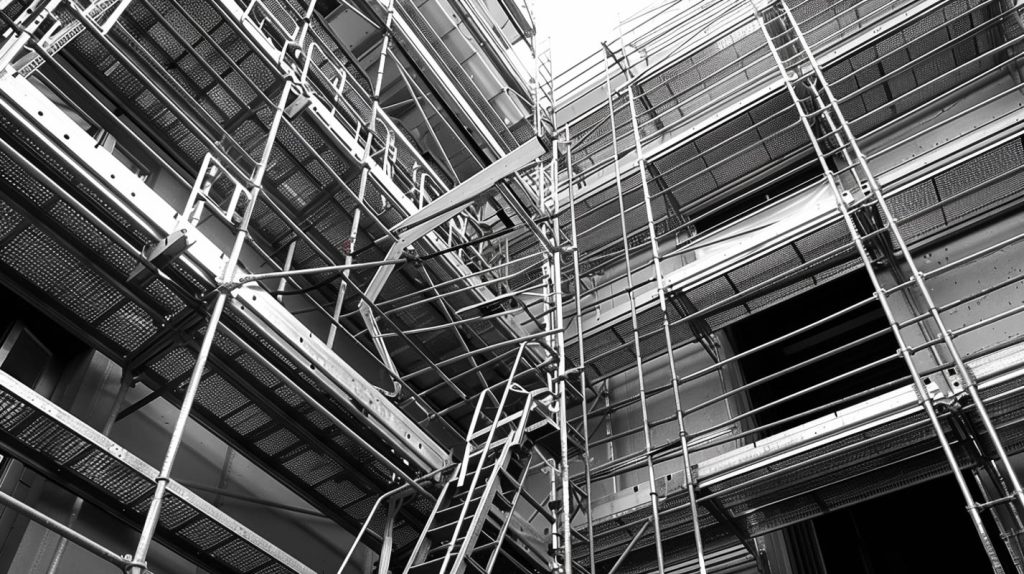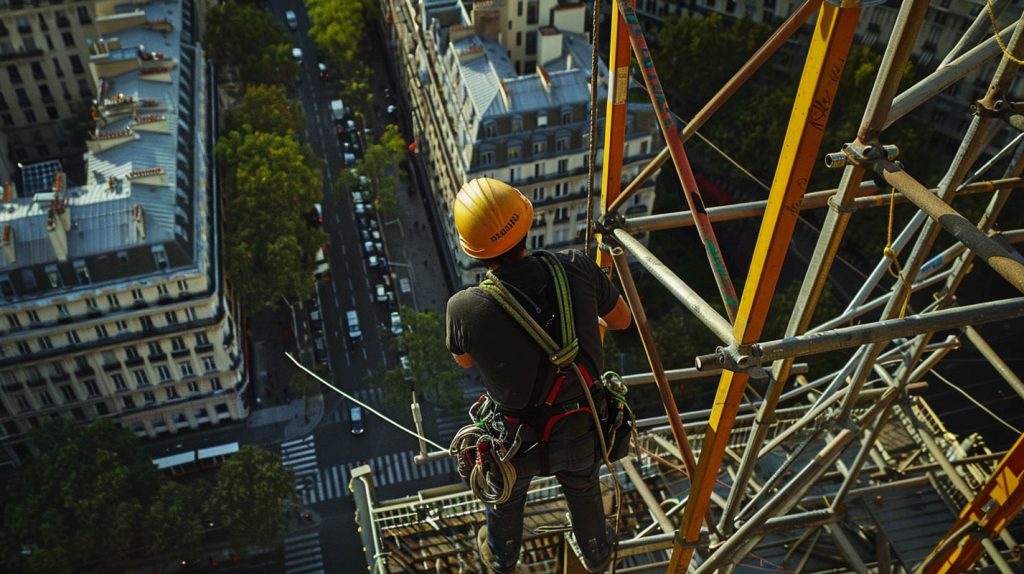Phone:
TBA
Physical address:
TBA
Estimating scaffolding costs involves several factors. First, choose the right type: supported, suspended, rolling, or cantilever. Consider material costs; aluminum is pricier but lightweight, while steel is cheaper but heavier. Labor expenses depend on hourly rates, skill level, and safety regulations. Project duration affects both rental and labor costs, so plan accurately. Ground stability and site accessibility also impact pricing. Don’t forget permits and regulations, which can add fees and require compliance. Accurate estimation requires measuring heights, factoring in delays, and comparing labor quotes. To master all these aspects and avoid budget surprises, there’s more you should know.

When estimating scaffolding costs, it’s crucial to understand the different types of scaffolding available. This knowledge will help you choose the right kind for your project, ensuring efficiency and safety while keeping expenses in check. Different types of scaffolding serve various purposes, and each has its advantages and limitations.
Firstly, there’s the supported scaffolding, which is the most common type. This type uses poles, frames, and supports to build a stable platform from the ground up. It’s ideal for work on buildings and structures where you need a robust and adaptable system. You’ll often see it in construction and maintenance projects due to its flexibility and strength.
Next, you have suspended scaffolding. This type hangs from the top of a building using ropes or chains. It’s particularly useful for high-rise buildings and tasks like window washing or exterior painting. Suspended scaffolding allows easy movement up and down, making it a preferred choice for work at significant heights.
Another type is the rolling scaffolding, which comes with wheels for easy movement. It’s perfect for tasks that require frequent repositioning, like painting large walls or installing electrical systems. However, it’s essential to ensure the wheels are locked in place while you’re working to maintain safety.
Lastly, there’s the cantilever scaffolding. This type stands out from the rest because it doesn’t require ground support. Instead, it’s anchored to a building’s structure, making it ideal for situations where the ground space is limited or obstructed.
Understanding these types will help you make an informed decision, ensuring your project runs smoothly and stays within budget. Go back to Scaffold for Hire Home Page.
When estimating scaffolding costs, you’ve got to consider the price differences between steel and aluminum. Don’t forget to factor in procurement and delivery fees, which can significantly impact your budget. Understanding these variables will help you make a more accurate cost projection for scaffold hire.
Comparing steel and aluminum for scaffolding, you’ll find that aluminum generally costs more upfront but may offer savings in the long term due to its lighter weight and corrosion resistance. While steel is heavier and tends to be cheaper initially, it can incur additional costs over time due to maintenance and potential corrosion issues.

When you’re choosing between the two, consider these factors related to scaffolding hire cost:
Ultimately, your decision will depend on your project’s specific requirements and budget. By weighing these factors, you can make a more informed choice that balances initial costs with long-term savings.
After deciding on the material, you’ll need to account for procurement and delivery fees, which can significantly impact your overall scaffolding costs. Procurement fees involve the cost of sourcing and purchasing the scaffolding materials. Depending on where you buy from, these costs can vary widely. Local suppliers might offer lower prices but limited stock, while larger suppliers could have higher prices but more availability.

Delivery fees are another essential factor. The distance between the supplier and your project site can affect delivery charges. If you’re working on a tight deadline, you might need expedited shipping, which will add to the costs. Also, consider the size and weight of the scaffolding material, as bulkier items generally incur higher delivery fees.
Labor expenses can significantly impact the overall cost of scaffolding projects. When you’re planning for scaffolding, it’s essential to consider the labor costs involved in the setup, maintenance, and dismantling of the scaffolding. These expenses can vary based on several factors, including the complexity of the project, the number of workers needed, and the duration of the job.
Here are some key points to keep in mind regarding labor expenses:
It’s crucial to get detailed quotes from scaffolding companies that include a breakdown of labor charges. This way, you can compare and choose the best option that fits your budget. Don’t just look at the lowest bid; consider the experience, reliability, and safety record of the workers. Investing in skilled labor can save you money in the long run by ensuring the job is done correctly and safely, reducing the risk of accidents and delays, thus impacting how much does scaffolding cost.
The duration of your scaffolding project will often directly influence the overall cost and planning required. Longer projects typically mean higher expenses, as you’ll be renting scaffolding for extended periods, and labor costs will accumulate over time. It’s essential to have a clear timeline to manage your budget effectively.
First, consider the scope of your project. A simple repair might only need a few days of scaffolding, while a complex construction or renovation could extend for months. Accurately estimating the duration helps you avoid surprises and keeps your project on track.
Next, think about potential delays. Weather conditions, supply chain issues, and unexpected structural problems can all extend your timeline. To mitigate these risks, build some buffer time into your schedule. This way, you won’t be caught off guard if things don’t go as planned.

Effective communication with your contractor can also play a crucial role. Regular updates and progress checks ensure that everyone is on the same page, helping to identify and address potential delays early on. This proactive approach can save both time and money.
Keep in mind that different scaffolding companies might have varying rental terms. Some offer daily rates, while others might provide discounts for weekly or monthly rentals. Understanding these options can help you choose the most cost-effective solution for your project’s duration.
Lastly, remember that proper planning and realistic timelines are key. Rushing through a project can lead to mistakes and increased costs, while overestimating time can tie up resources unnecessarily. Balancing efficiency with accuracy ensures your scaffolding project remains within budget and on schedule.
When estimating scaffolding hire cost, don’t overlook the site conditions. You’ll need to assess ground surface stability to ensure safe setup, and consider accessibility and space constraints that could impact labor and equipment needs, ultimately affecting the scaffolding hire cost. Each of these factors can significantly influence your overall budget.
Understanding ground surface stability is crucial for ensuring safe and effective scaffolding installation. You need to evaluate the ground conditions meticulously because unstable surfaces can lead to scaffold collapse, causing severe injuries and costly damages, impacting your overall scaffolding hire cost. Here’s what you should look out for:

Navigating narrow pathways and confined spaces can significantly complicate scaffolding installation. When you’re dealing with tight site conditions, the complexity of your project increases. You’ll need to account for the extra time and effort required to maneuver scaffolding materials through limited access points. This often means smaller, more modular pieces will be necessary, which can add to your costs.
Space constraints also make it harder to store materials and equipment on-site, potentially requiring additional off-site storage solutions. You might even have to schedule multiple deliveries, adding to logistical challenges and further inflating your budget. Think about the added labor costs too. Workers will need more time to assemble, adjust, and disassemble scaffolding in cramped conditions, which can lead to higher labor expenses.
Don’t forget about safety either. Limited space can increase the risk of accidents, necessitating more rigorous safety measures, which again can drive up costs. Permits and regulations might also be stricter in areas with accessibility issues, requiring you to spend more time and money to ensure compliance. Overall, understanding and planning for the challenges posed by accessibility and space constraints is crucial for accurate scaffolding hire cost estimation.
Securing the necessary permits and adhering to regulations is crucial for any scaffolding project to ensure safety and compliance, impacting the overall scaffolding hire cost. Without the proper documentation and adherence to local laws, you risk not only hefty fines but also the safety of everyone involved. So, what exactly do you need to consider?

First, understand that different regions have varying requirements that can affect how much does scaffolding cost. Some areas might mandate specific types of permits for different heights or types of scaffolding. It’s essential to research local building codes and regulations closely. You can’t afford to overlook this step, as it could delay your project significantly.
Furthermore, it’s important to regularly update your knowledge on these regulations. Laws and guidelines can change, and staying current ensures you’re always compliant. Ignorance isn’t an excuse in the eyes of the law when it comes to obtaining the proper permits for a scaffolding job.
Here are some key considerations:
When estimating scaffolding costs, it’s essential to consider multiple factors to ensure accuracy and avoid budget overruns. First, take into account the type and complexity of the project. Different projects require different scaffolding systems, and each comes with its own cost implications. For instance, a high-rise building will need more extensive scaffolding than a single-story structure.
Next, measure the height and total area that requires scaffolding. This will help you calculate the amount of material needed. Don’t forget to factor in the duration of the project. Longer projects will naturally incur higher rental costs for the scaffolding equipment.


Labor costs are another critical factor. Skilled labor for erecting and dismantling the scaffolding can be expensive, so it’s crucial to get quotes from multiple providers to find the best deal. Make sure you include any additional labor for safety inspections and maintenance throughout the project.
Weather conditions can also impact your cost estimations. Bad weather can delay the scaffolding job and increase rental and labor costs. It’s beneficial to have a contingency plan and budget for unexpected delays.
Additionally, consider transportation costs. Moving scaffolding materials to and from the site can add a significant amount to your budget, especially if the site is in a remote location.
Lastly, always account for permits and regulatory compliance costs. Ensure you’re aware of all local regulations and include these expenses in your scaffolding hire cost estimate.
Scaffolding can significantly affect your project’s timeline. It ensures workers can safely reach necessary heights, which speeds up construction. However, setting up and dismantling scaffolding takes time, potentially causing delays if not planned correctly.
You’ve got to factor in safety measures like guardrails, non-slip surfaces, and regular inspections when estimating costs. Don’t forget training for workers and ensuring compliance with regulations to prevent accidents and fines.
Absolutely, weather conditions can impact costs. You’ll need to account for potential delays, damage to materials, and additional safety measures. Harsh weather may require sturdier structures, increasing both labor and material expenses.
Insurance requirements can significantly influence your expenses. Higher coverage can raise costs, while insufficient insurance might leave you liable for damages. You’ll need to balance adequate protection with budget considerations to manage overall expenses effectively.
You might overlook hidden costs like permit fees, site preparation, and weather delays. Don’t forget maintenance and inspection charges, too. These can sneak up on you and inflate your project’s budget significantly.